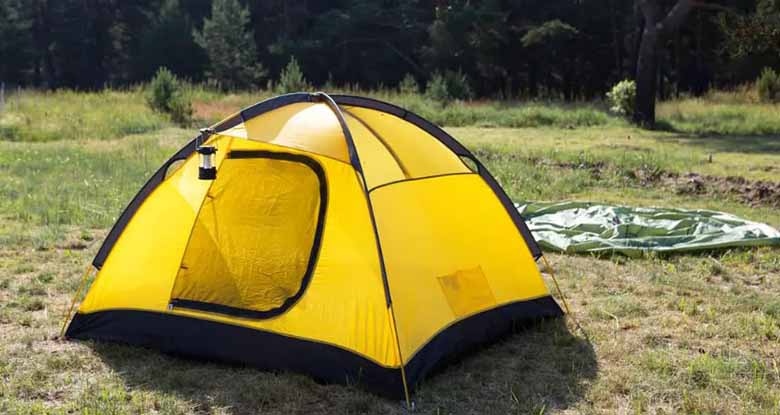How to Remove Mold from a Tent: Best Guide to Know in 2023.

As you go on a journey with your camping gear and all, keep in mind that the tent will shelter you, and therefore it needs to be protected. You can fend off the damage if you know the steps of how to remove mold from a tent.
Only then it can protect you back. Tents mostly get damaged due to mold formation, which also makes the tent look unattractive.
The work does have a bit of cleaning and polishing to do. If you have determination, it will go up all the problems, and your tent will get a new life; this is what matters.
Why Should We Remove Mold from Tent?
A tent that has mold on can be ill-favored for your stay. Moreover, molds are basically fungus, and you could be allergic to such species and easily put your health at risk. After every camping trip, your tent could look ragged and dirty all the way, but it is just part of a camping trip, and you don’t need to worry about it.
If you clean your tent on time, after every use, you could easily sleep in it the next time you go camping. In the next sections, we will cover how to remove mold from a tent to relieve your worries.
What Causes Mold?
Mold tends to appear everywhere, from clothes to skin, fur, fabric worn materials, and many other places. Molds are dangerous in low light and damp environments, it can also be harmful even above freezing temperature.
Why is it necessary to treat mold?
Molds multiply fast and can spread through water and air, populating the surrounding in no time. Growing molds will weaken your tent super-fast; it will take a toll on your camping as it will rot the fabrics of your tent and tear holes on it with time.
Molds can also make you ill; if you have breathing problems, it can affect you to a greater extent and can also irritate your skin, eyes, and other parts of your body. So it is better to counter the mold and treat it before it treats you in a damaging way.
How to know if there is mold in the tent?
In case you don’t know if there is mold in your tent, then by thorough inspection, you will be able to know about it. Not all unclean spots are mold. Dirt can be easily wiped off, but it will hang onto the fabric or surface and will take deep cleaning. Molds can form due to humidity.
Therefore you can feel the moisture in the environment around you if there is mold contamination. You can observe the color and tell if it’s a mold. Molds are greenish, bluish in color, the color and create soggy patches around them. The smell is distinctive, too; molds have a pungent smell.
Related:
Cleaning procedure
The mold on a tent should be visible because of the distinct coloring and the decaying state of the fabric. Once you see the mold formation, don’t think you are doomed or your tent is not usable anymore.
The good news is, if you know how to remove mold from a tent, you will be repairing it in no time, and therefore the tent can be made new. You have to follow a guideline, and safety precautions have to be taken as well. Gather your belongings, like protective gloves, lukewarm water, vinegar mixture, lemons, and brushes.
- First and foremost, start with cleaning the surface molds by gently brushing off the trash.
- Grab a spraying bottle and a sufficient amount of vinegar, pour the distilled vinegar into the spraying bottle, and you are ready for some sprinkle.
- Keep in mind. Undiluted white vinegar is an excellent solution in preventing mold formation and stains.
- Spray a substantial amount of vinegar on the affected area.
- Allow sufficient time, for like one hour, let the vinegar solution settle, and beneficially work its magic.
Vinegar is extremely influential on its own, but to make your tent look perfect, you can also use baking soda, salt, or any other powerful cleaning agent with it, except bleaching powder.
- The next step, use a scrubber to break the molds and clean the surface accordingly.
- Don’t scrub too hard or too lightly; you will get hold of the pace as you rip off the molds.
- Once the molds have been offloaded, use warm water and thoroughly clean the surface with it.
- The next process is critical in taking care of your tent’s mold.
- You must dry out your whole tent once the cleaning is done; otherwise, if you store dried and watery fabric, molds will start gathering up again.
- Dry your tent, and once it’s completely done, store your tent in a hygienic, ventilated place, you don’t want additional moisture to ruin things for you.
Polishing the stains
Molds leave their footprint in terms of stains. Even if you’ve washed your tent, dried it, you might see patches here and there; this is unavoidable. You don’t want to over wash and decrease the lifespan of your tent fabric. If there are mildew stains, be clever.
Use a chlorine cleanser like X-14 Mildew remover. For unknown stains, use the MR Clean magic eraser, a sponge-like product that takes off stains.
If nothing works, give the affected area a cleansing using extracted lemon water and salt, scrub it and get off as many stains as possible. Keep in mind, the stains will not fade away 100%, but you can use these techniques to make the stains look minimal.
Removing the smell
The moldy smell can be mood-killing. The smell is not only bad; the moisture a mold gathers generates an acrid smell. Even when you’ve cleaned your tent, you can still breathe some foul odor inside the tent.
To get rid of the smell, you need to take care of the situation once the cleaning is done. It would be best if you were not tempted to use room fresheners because they will only cover the smell for you.
Once the fragrance fades, the overpowering mouldy smell will be back to haunt you. You can use odor removing sprays available on the market. Another viable solution is to wash the tent with vinegar, lemon drops, and water solution.
Don’t pack up the tent or start using it right after the wash. Let it dry out completely, and you will have a pleasant-smelling tent.
Prevention
Drying you the tent is the most important step for maintaining your camping tent. After you are done camping, wash the tent, the washing procedure is already mentioned in this article. Once you are done, always make sure to dry your tent completely before storing it.
Otherwise, you will be aiding it to form mold again. The trapped water particles will form an unbearable smell and, in time, form a mildew stain. Also, try to keep the tent as dry as possible when you are using it.
You have to make sure rainwater is not collected somewhere and the tent is not piled up with debris. Clean it if you see the tent deteriorating. Inspect the tent now and then. This will reduce your aftercare trouble.
Keep your tent in an air-flowing area and not somewhere damp. Good ventilation will prevent moisture from getting trapped. Thus mold will be out of the game.
Related Content
Conclusion
If you see the mold on top or a surface, try to brush it off using soft bristles to edge it off the surface. Loose molds will get off easily just by brushing. The next step is to use vinegar, and white vinegar kills 82% of mold species.
Spray vinegar on the surface or the affected area to kill the remaining traces of it. Don’t use bleach or chlorine; these chemicals will tamper the tent fabric and dampen the color of your tent.
Tents are made of different fabrics, from canvas, cotton, polyester, to nylon. Each fabric has its ability. Before you apply cleaning chemicals, make sure the solution is out of harm’s way. Then you have to clean the tainted area with warm water and scrub the patches with a scrub brush. Don’t fold or pack a wet tent. Make sure you hang the tent to dry out completely before preserving it.
